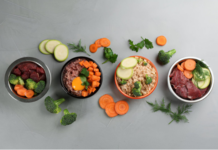Last Updated on May 17, 2024 by Dogs Vets
Discover the secret to successful dog training with the best dog food for training. Fuel your pup’s potential with proper nutrition!
Understanding the Importance of Nutrition in Dog Training
Proper nutrition plays a vital role in the success of dog training. When it comes to training your furry friend, providing them with the right food is essential for their overall health and well-being. Understanding the significance of nutrition in dog training is crucial for achieving optimal results.
The Role of Proper Nutrition in Dog Training
Nutrition is the foundation of a dog’s physical and mental health. Just like humans, dogs require a well-balanced diet to support their growth, energy levels, and cognitive function.
When a dog is adequately nourished, they are more likely to exhibit better focus, improved memory retention, and increased motivation during training sessions.
A diet rich in essential nutrients, such as protein, vitamins, and minerals, provides the building blocks for a healthy body and a sharp mind.
Protein, in particular, is crucial for muscle development and repair, which is essential for dogs undergoing physical training. Additionally, a balanced diet supports the immune system, making dogs more resilient to illness and stress.
Impact of Quality Food on Training Success
The quality of food you feed your dog can significantly impact their training success.
High-quality dog food is formulated to provide the right balance of nutrients, ensuring that your dog receives optimal nutrition. It contains carefully selected ingredients that meet the specific dietary needs of dogs, including the appropriate protein, fat, and carbohydrate levels.
When choosing dog food for training purposes, it’s important to prioritize ingredients that promote overall health and performance. Look for dog food options that are free from artificial additives, fillers, and by-products.
Opting for a nutritionally dense diet can provide your dog with the energy they need to engage in training activities and maintain focus.
A well-nourished dog is more likely to respond positively to training exercises, making the learning process smoother and more effective. Additionally, a high-quality diet can contribute to a shiny coat, healthy skin, and overall vitality, which can enhance your dog’s appearance and well-being.
By understanding the role of proper nutrition in dog training and the impact of quality food on training success, you can make informed decisions about your dog’s diet.
Consult with your veterinarian to determine the best dog food options for your canine companion based on their specific nutritional requirements. Remember, a well-fed and healthy dog is more likely to excel in their training journey.
Key Nutritional Factors for Training
When it comes to training your dog, nutrition plays a vital role in their overall health and performance. Providing the right balance of nutrients is essential for their energy levels, focus, and overall well-being. Here are the key nutritional factors to consider when choosing the best dog food for training.
Protein Content
Protein is an essential nutrient for dogs, especially when it comes to training. It provides the building blocks for muscle growth, repair, and overall development. Dogs require a higher protein content in their diet compared to other animals.
Aim for dog foods that have a moderate to high protein content. The protein source should be of high quality and easily digestible, such as chicken, beef, or fish. Consult the product label or consult with your vet to ensure the protein content meets your dog’s specific needs.
Fat Content
Fat is another important nutrient for training dogs. It serves as a concentrated source of energy and helps maintain healthy skin and coat. Additionally, fat enhances the palatability of dog food, making it more appealing to your furry friend.
Look for dog foods that contain a moderate amount of healthy fats, such as omega-3 and omega-6 fatty acids. These fats have numerous benefits, including supporting brain function and reducing inflammation. It’s important to note that fat content should be balanced to avoid excessive weight gain, especially for dogs with lower activity levels.
Carbohydrates and Fiber
Carbohydrates provide dogs with energy, but the type and amount of carbohydrates in their diet should be carefully considered. While dogs are primarily carnivores, they can still benefit from a moderate amount of carbohydrates in their diet.
Choose dog foods that contain complex carbohydrates, such as whole grains or vegetables. These provide a slow and steady release of energy, helping your dog maintain endurance during training sessions. Additionally, fiber is an important component of carbohydrates that aids in digestion and helps regulate bowel movements.
To get a better idea of the nutritional composition of different dog foods, refer to the product labels. These labels provide detailed information about protein, fat, carbohydrate, and fiber content. Consulting with your vet can also help determine the ideal nutritional balance for your dog’s specific needs.
By considering the protein content, fat content, and carbohydrates in your dog’s diet, you can ensure they have the necessary nutrients to support their training efforts.
Remember, every dog is unique, so it’s important to tailor their diet to their individual needs. Monitoring their progress and making adjustments as needed will help them achieve optimal performance during training sessions.
Types of Dog Foods for Training
Choosing the right type of dog food for training is essential to support your furry friend’s overall health and optimize their learning potential. There are several options available, each with its own benefits and considerations. Let’s explore three common types of dog foods for training: dry dog food, wet dog food, and a raw food diet.
Dry Dog Food
Dry dog food, also known as kibble, is a popular choice for training purposes. This type of food is convenient, easy to store, and has a long shelf life. Dry dog food is typically formulated to provide a balanced diet, containing a combination of protein, fat, carbohydrates, vitamins, and minerals.
One advantage of dry dog food is its affordability and accessibility. It is available in various formulations tailored to different life stages and specific dietary needs. Dry dog food is often used as training treats due to its small size and chewy texture, making it easy to carry and dispense during training sessions.
Wet Dog Food
Wet dog food, as the name suggests, has a higher moisture content compared to dry dog food. It usually comes in cans or pouches and contains a combination of meat, vegetables, and grains. The texture and aroma of wet dog food can be enticing to dogs, making it an excellent choice for training rewards.
Wet dog food provides hydration and can be particularly beneficial for dogs who struggle to drink enough water. It is also a suitable option for dogs with dental issues or those who are picky eaters. However, it’s important to note that wet dog food generally has a shorter shelf life once opened and may be more expensive compared to dry dog food.
Raw Food Diet
A raw food diet, also known as a raw or BARF (Biologically Appropriate Raw Food) diet, consists of uncooked ingredients such as raw meat, bones, fruits, and vegetables. This approach aims to mimic a dog’s natural diet in the wild. Raw food diets are often prepared at home or purchased from specialty pet food stores.
Proponents of raw food diets claim that they provide numerous health benefits, including improved digestion, coat quality, and energy levels. However, it’s important to note that raw food diets require careful planning and consultation with a veterinarian to ensure that dogs receive all the necessary nutrients.
| Type of Dog Food | Benefits | Considerations |
|---|---|---|
| Dry Dog Food | – Convenience and affordability \n – Balanced nutrition \n – Suitable for training treats | – May contain additives and fillers \n – Lower moisture content |
| Wet Dog Food | – Higher moisture content \n – Palatable for dogs \n – Suitable for dogs with dental issues | – Shorter shelf life once opened \n – Can be more expensive |
| Raw Food Diet | – Mimics natural diet \n – Potential health benefits \n – Allows for more control over ingredients | – Requires careful planning and preparation \n – Potential nutrient imbalances \n – Increased risk of bacterial contamination |
When choosing the best dog food for training, it’s important to consider your dog’s specific needs, dietary requirements, and consult with your veterinarian.
Remember that treats used during training should make up only a small portion of your dog’s overall diet. Focus on providing a well-balanced and nutritionally complete diet to support their overall well-being.
Choosing the Best Dog Food for Training
When it comes to training your dog, choosing the right food plays a crucial role in their overall health and success during training sessions. Here are some factors to consider when selecting the best dog food for training.
Reading Labels and Ingredients
One of the key steps in choosing the right dog food for training is to carefully read and understand the labels and ingredients. Look for high-quality ingredients that provide essential nutrients for your dog’s well-being. Avoid foods that contain artificial additives, fillers, and by-products.
Look for specific information on the protein, fat, and carbohydrate content. Protein is particularly important for muscle development and repair, while fat provides a concentrated source of energy. Carbohydrates provide the necessary fuel for physical activity. Refer to our article on dog nutritionfor more detailed information.
Consulting with Your Vet
Consulting with your veterinarian is an essential step in choosing the best dog food for training. They can provide valuable insights into your dog’s specific nutritional needs based on factors such as age, breed, size, and any existing health conditions.
Your vet can recommend a suitable diet that aligns with your dog’s training goals and overall well-being. They may also suggest specific dietary considerations or recommend specialized diets if necessary.
Considering Your Dog’s Specific Needs
Every dog is unique, and their nutritional needs may vary. Consider your dog’s specific needs when selecting the best food for training. For example, puppies require a different balance of nutrients compared to adult dogs. Dogs with allergies or sensitivities may benefit from hypoallergenic or limited ingredient diets.
Dogs with specific health conditions may require specialized diets. By considering your dog’s individual requirements, you can choose a food that supports their overall health and enhances their training performance.
Remember, it is crucial to introduce any new food gradually to avoid digestive upset. Transitioning over a period of a few weeks allows your dog’s digestive system to adjust to the new diet. If you have any concerns or questions about your dog’s nutrition, seek guidance from a professional, such as a dog behaviorist or dog obedience trainer, who can provide expert advice tailored to your dog’s needs.
Choosing the best dog food for training is an important aspect of your dog’s overall well-being and training success. By reading labels and ingredients, consulting with your vet, and considering your dog’s specific needs, you can make an informed decision that supports their health and enhances their training progress.
Feeding Schedule for Training Success
Establishing a proper feeding schedule is crucial when it comes to training your dog. A consistent and well-planned routine not only helps optimize their training sessions but also contributes to their overall well-being. In this section, we will explore the timing of meals, the use of treats and rewards, as well as the importance of hydration and water intake.
Timing of Meals
When designing a feeding schedule for your training sessions, it’s important to consider the timing of your dog’s meals. It is generally recommended to feed your dog at least one to two hours before a training session. This allows for proper digestion and reduces the chance of discomfort during training. Additionally, avoid feeding your dog immediately after training to prevent any digestive issues.
Creating a consistent schedule by feeding your dog at the same time each day can help regulate their appetite and digestion. However, keep in mind that individual dogs may have different dietary needs and preferences. Consult with your veterinarian to determine the best feeding schedule for your dog based on their age, breed, and activity level.
Treats and Rewards
Treats and rewards play a vital role in dog training, as they reinforce positive behavior and help your dog understand what you expect of them. When selecting treats for training, choose options that are small, soft, and easily chewable. This allows for quick consumption and prevents distractions during training sessions.
It’s important to keep in mind that treats should be used in moderation, taking into consideration your dog’s overall calorie intake. Treats should make up only a small portion of their daily diet to maintain a balanced nutritional profile.
For more information on training treats and their role in dog training, refer to our article on dog obedience training London.
Hydration and Water Intake
Proper hydration is essential for your dog’s overall health and well-being, including their training performance. Always ensure that fresh, clean water is readily available to your dog during training sessions. Encourage regular water breaks to prevent dehydration and maintain their energy levels.
Monitoring your dog’s water intake is important, especially during hot weather or intense training sessions. Dogs may require more hydration during these times to stay properly hydrated. Keep an eye on their water bowl and refill it as needed throughout the day.
By incorporating a well-planned feeding schedule into your training routine, you can optimize your dog’s training sessions and overall performance. Remember to consider the timing of meals, choose appropriate treats and rewards, and ensure proper hydration for a successful training experience.
For more information on dog training and behavior, explore our articles on dog behaviorist London, puppy training classes London, and dog training schools in London.
Monitoring Your Dog’s Progress
As you embark on your dog training journey, it’s important to monitor your furry friend’s progress to ensure they are on the right track. By observing certain aspects of your dog’s well-being, you can gauge their response to the training program and the impact of their diet.
Here are three key areas to keep an eye on: energy levels, coat and skin health, and behavioral changes and training performance.
Observing Energy Levels
A dog’s energy levels can provide valuable insights into their overall health and well-being. During training, you should observe whether your dog exhibits an appropriate level of energy and enthusiasm.
If your dog seems excessively lethargic or lacks enthusiasm during training sessions, it may be an indication of an underlying health issue or potential nutritional deficiencies.
It’s essential to remember that energy levels can vary depending on the breed, age, and individual characteristics of your dog. Monitoring changes in energy levels over time can help you identify any patterns or deviations from their usual behavior.
If you notice significant changes or concerns regarding your dog’s energy levels, it’s advisable to consult with a professional, such as a dog behaviorist or veterinarian.
Assessing Coat and Skin Health
The condition of your dog’s coat and skin can be a reflection of their overall health and the quality of their diet. A healthy, shiny coat and well-nourished skin are indicators of a balanced and nutritious diet. Conversely, dry skin, excessive shedding, or a dull coat may suggest nutritional imbalances or deficiencies.
Regularly assess your dog’s coat and skin for any signs of abnormalities or changes. Look for a lustrous coat, free from excessive dandruff or flaking. Healthy skin should be supple and free from redness, irritation, or hot spots.
If you notice any concerns, it may be worth reviewing your dog’s diet and consulting with a veterinarian to ensure they are receiving the necessary nutrients.
Behavioral Changes and Training Performance
Observe your dog’s behavior and training performance throughout their training program. Positive changes in behavior, such as improved focus, responsiveness, and obedience, can indicate that your dog is benefiting from the training and a well-rounded diet.
On the other hand, if you notice regressions in behavior or difficulties in training, it may be worth assessing whether any dietary factors are contributing to these changes.
Consistency is key when it comes to training, and it’s important to consider that behavioral changes may also be influenced by factors beyond diet alone. If you have concerns about your dog’s behavior or training progress, seeking guidance from a dog obedience trainer or behaviorist can provide valuable insights and assistance.
By monitoring your dog’s energy levels, coat and skin health, and behavioral changes, you can better understand how their diet and training program are impacting their overall well-being.
Remember that each dog is unique, and their response to training and diet may vary. If you have any specific concerns or questions, consulting with a professional, such as a veterinarian, can provide tailored advice for your dog’s individual needs.
Fact Check
We strive to provide the latest valuable information for pet lovers with accuracy and fairness. If you would like to add to this post or advertise with us, don’t hesitate to reach us. If you see something that doesn’t look right, contact us!

















